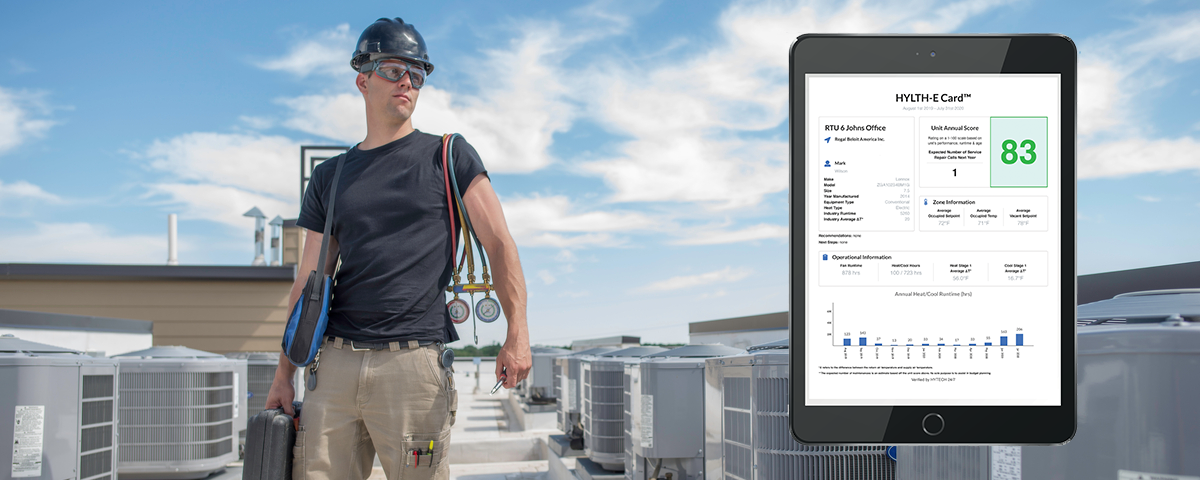Building Trust with Customers Using HVAC Unit Scorecards Built from Aggregated Data

HVAC maintenance is quickly evolving in the digital age; it is no longer an archaic, hours-long list of tasks and knick–knacks. Powered by HVAC data trends, technicians can see past the veil and gain insight on problems with an asset, apply remote access capabilities to prevent damage 24/7, and much more. HVAC contractors are also using the application of new, data-driven HVAC unit scorecards to reveal insights into unit life expectancy and performance. This is the HYTECH 24/7’s HYLTH-E Card®, and it is critical to build trust among HVAC service contractors’ clients for several data-based reasons.
What Are HVAC Unit Scorecards?
HYTECH 24/7’s HYLTH-E Card® is a leading HVAC unit scorecard that applies smart technology to aggregate data and analyzes unit operating metrics. Analytics parameters and historic field-testing data allow for more informed insights into the function of a unit. Essentially, the scorecard is the result of fourth-generation contractors’ experience, who identified, verified, and tested metrics to understand what an asset really does prior to malfunction. It is the small trends that go unnoticed that can have a massive impact on HVAC maintenance and replacement.
The HYLTH-E Card® considers the age, maintenance history, and performance of a unit based on data. Face the facts; all units will eventually fail. So, the question becomes, is it better to plan for that failure and smartly put it off through predictive maintenance that keeps costs under control? Or would companies rather wait for it to break, spend extra money to figure out what’s wrong, and still end up with the possibility of replacing the unit?
Chances are good that the data-driven approach is the answer most will give; it validates all planning decisions and helps with capital budgeting and maximizes value for HVAC system owners. Therefore, the HYLTH-E Card® is a critical aspect of applying data and truly maximizing HVAC asset longevity.
The Benefits of Using HVAC Unit Scorecards
Scorecards provide more transparency into HVAC unit performance, and since customers can see in real-time how systems are functioning, they are more likely to understand why services are needed. Traditional sources of conflict in HVAC maintenance involved a loss of trust and a sense that system owners had to simply hope the contractor was honest. Now, the data trends reveal the truth behind the contractor recommendations, and new opportunities are under development. The opportunities to apply data are still relatively new, and that’s what makes the HYTECH 24/7 HYLTH-E Card® so innovative. According to ACHR News, “contractors can run performance checks after installing a new system to ensure accuracy and reduce callbacks. Sensors, IP, and predictive maintenance are just the tip of the iceberg for the HVACR marketplace. Education and experimentation have been suggested by several manufacturers, but as with any innovation, new adaptations are always just around the corner.” These adaptations are already present and available through HYTECH’s wicked smart algorithms and easy-to-use dashboards.
Opportunities to Collect Data and Reduce HVAC Unit Total Cost of Ownership
Collecting and applying data is also much more than an annual process. While HVAC unit scorecards can provide a snapshot of what to expect from HVAC maintenance needs for a given quarter or year, the opportunities to collect and apply data have a dramatic impact on total cost of ownership for an HVAC system. The snapshot in the form of the patent-pending HYTECH 24/7 HYLTH-E Card® reveals more about the overall condition and performance of the units in question, including:
- Unit strain derived from the supply air delta, measuring how effective a unit is operating.
- Unit efficiency, alluding to how much energy is used and whether the unit needs additional servicing.
- Unit efficacy, describing how well the unit is able to achieve its purpose, attaining the right environment within the facility.
- Airflow, which is indicative of clear filters and unobstructed ducts.
- The presence of allergens and pathogens, helping companies improve occupant health.
- Excessive runtime, such as poor system layout that results in a disproportionate runtime schedule.
- Vacancy runtime, resulting higher costs without any benefit to building occupants.
- Maintenance scheduling and diagnosis to prevent unplanned downtime and intervene when issues do arise unexpectedly.
Take this example from a past HYTECH client.
Following the collection and analysis of data, the client wanted to know what unit they should earmark for replacement in the coming year. With six units, this could historically fall to the oldest unit on the roof regardless of how the units run. The data in the scorecards revealed that two units were both scoring well below the others but weren’t necessarily the oldest. Being able to explain that the units were running at such different intervals due to nature of the space, the client felt more comfortable actually paying to replace the unit. Additionally, seeing two the two units scoring around the same, they were able to take the scores to the finance director and get more money to replace both. Changing both alleviated the strain, reduce the energy use by the facility, and provide greater comfort.
Start Aggregating HVAC Unit Data With HYTECH
Modern HVAC maintenance is built on the use of HVAC unit scorecards. Unlike the systems of the past, modern HVAC maintenance programs rely on the scrutinization of millions of data points to derive an easy-to-understand, digestible measurement of unit performance. Get started with yours by visiting HYTECH online today.
